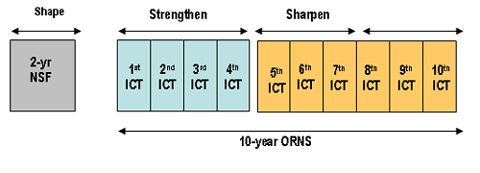|
|
¡¡
 Previous FrontPage Edition 12 Aug
2005
Previous FrontPage Edition 12 Aug
2005
|
Back to
FrontPage
of Article
|
|

|
|
|
In-camp Training
for National Servicemen cut to 10 years |
|
¡¡ |
|
|
Factsheet - Enhanced National Service Training System
Current NSTS
The current 10 + 3 National
Service Training System (NSTS) for Operationally Ready National
Servicemen (ORNS) was implemented in April 2003. It comprises 10
years of In-Camp Training (ICT) and three 2-day Basic Individual
Training (BIT), for a total of 13 years of ORNS.
Enhanced NSTS
With effect from 1 April 2006, NS units will serve only 10 years of
ICT. There will be no requirement for the 3 BIT years.
National Service will now be a 2 + 10 training continuum comprising
2 years of active NSF training and 10 years of ORNS ICT. The
structure of the revised NSTS is as follows:
¡¡

a. Shape Phase (2-year NSF).
Units would have trained to the required level of proficiency during
their active 2¨Cyear NSF ¡°Shape¡± phase. The 10-year ORNS phase
primarily structures currency training to maintain the operational
readiness of the units.
b. Strengthen Phase (1st to 4th
ICT). This phase remains unchanged from the current system. As
the NS unit would have just transited from its active phase,
training will focus on strengthening the component level
competencies to maintain the unit¡¯s operational readiness.
c. Sharpen Phase (5th to 7th ICT).
NS units will intensify their training to prepare for the external
evaluation in the 7th ICT. The result of the external evaluation,
together with the unit¡¯s demonstrated performance over the last 7
years, will be used by the NS commander and Higher HQ to customise
the training requirements in the subsequent two ICTs.
d. Sustain Phase (8th to 10th
ICT). The training outcomes in the 8th and 9th ICT depend on the
demonstrated performance of the unit¡¯s previous ICTs.
Key Features of the Enhanced NSTS
Performance-based Training.
In the comprehensive 10-year ORNS training plan, the conditions for
performing the required training tasks and the standards to be
achieved are clearly stipulated. Hence, performance-based training
has been enhanced.
Greater Ownership for Commanders.
The revised NSTS gives commanders ownership for their training
activities in ICTs. NS commanders can shape their ICT training
according to the desired training outcomes and performance
standards. Training time can be adjusted according to the
achievement of the training outcomes. In addition, with the
implementation of the Multi-Year Assessment System (see below), NS
commanders will be able to better schedule future training according
to their unit¡¯s demonstrated performance in previous ICTs.
Multi-Year Assessment System
(MAS). The MAS builds upon the current Best NS Unit Competition
(BNSUC). The MAS has two parts ¨C a 7-year continual assessment
system and an external evaluation in the 7th year. The MAS scores
measure operational proficiency, cohesion and operational readiness.
If the MAS score shows that an NS unit has clearly performed above
the required training standards over the first 7, the unit commander
can choose to calibrate his unit¡¯s training tempo in their 8th and
9th ICTs accordingly. This system will motivate the NSmen to
consistently strive to achieve a high standard of performance in
every ICT.
¡¡
Source:
www.mindef.gov.sg News Release 11
Aug 2005
 |
|
|
¡¡
|
|